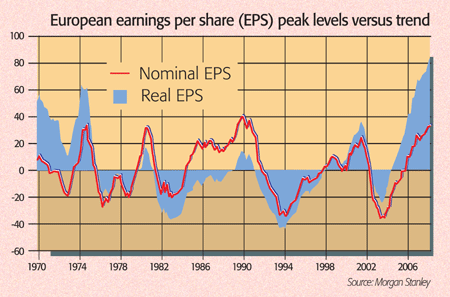In rough times, "optimists visualise a V-shaped chart", with a sharp drop followed by a rapid rebound, says Lex in the FT. Enter the profits forecasts for the S&P 500: Thomson Financial estimates that earnings slid by an annual 21% in the fourth quarter, but in the third quarter of this year earnings are expected to rise by 19%.
Yet another year of outsized earnings growth makes "V unlikely", as Lex puts it. The macroeconomic outlook grows darker by the day. The Fed cut its growth estimate to 1.6% for this year, highlighting downside risks to the outlook amid tightening credit and the ongoing slide in house prices; it was "about as bearish a forecast as we can see from the Fed", says InvestorsInsight.com's John Mauldin.
Meanwhile, a gauge of manufacturing activity in the northeast fell further into recession territory. To make matters worse, the spectre of stagflation is back, with inflation jumping from 2% in August to 4.3% in January.
MoneyWeek
Subscribe to MoneyWeek today and get your first six magazine issues absolutely FREE

Sign up to Money Morning
Don't miss the latest investment and personal finances news, market analysis, plus money-saving tips with our free twice-daily newsletter
Don't miss the latest investment and personal finances news, market analysis, plus money-saving tips with our free twice-daily newsletter
In Europe, analysts are also reaching for the stars. As Bryce Elder of Hemscott points out in The Times, the average forecaster is pencilling in profit growth of around 10% for Europe this year as they did during the last two recessions, when earnings dropped by up to 30%. "The teenage scribblers never see the monster coming." In the past four earnings recessions, profits fell by an average of nearly 40% from peak-to-trough and stocks posted an average decline of 33%. The MSCI Europe index is now down around 20% from its summer peak.

An earnings downturn is "unavoidable", says Morgan Stanley: the world is slowing, the US is in recession, and profits, margins and returns on equity are at record highs; real earnings per share are 83% above trend. US profit growth, the best leading indicator for the European profits, is negative.
A nearer-term worry is that throughout the credit crisis equity investors have been "steps behind" their credit market counterparts, says Jeffrey Goldfarb on Breakingviews. So the latest worrying signals from the credit markets, jitters over corporate defaults, suggest the equity market may have to catch up to credit by falling. The iTraxx Crossover index of mostly junk-rated firms, tracking the cost of insuring these corporate bonds, hit a record 614 basis points last week. It cost e600,000 a year to insure e210m of Crossover debt for five years. This also implies that the average company in the index would have to pay 6% above the risk-free rate in the bond markets.
Insuring investment-grade firms against default also cost more than ever last week. Persistently high spreads suggest companies will have trouble raising new debt or refinancing, which will put pressure on earnings, says Joanna Chung in the FT.
There was better news on monolines this week. Ratings agency S&P affirmed AAA ratings for the top two US bond insurers, Ambac and MBIA, and said the latter was no longer at risk of a downgrade now that it had raised additional capital. Ratings agency Moody's also reaffirmed MBIA's rating. But both could still downgrade Ambac if the rescue plan involving a capital injection from various banks comes to nothing. And Moody's is still reviewing both firms for a potential downgrade. Ambac guarantees $550bn worth of bonds; a downgrade implies a reduction in the value of the bonds it insures and more writedowns for banks.
Even if downgrades of monolines can ultimately be avoided, the global financial system would still have to work through hundreds of billions of dollars of bad loans. Credit card and commercial real estate, where delinquencies have reached a decade high, are the next likely "casualties of the credit collapse", says Alan Abelson in Barron's. These areas alone could generate $100bn-$200bn of losses, says Gillian Tett in the FT. Given lower growth, wildly optimistic earnings and more credit upsets in the pipeline, this bear looks far from over.
Get the latest financial news, insights and expert analysis from our award-winning MoneyWeek team, to help you understand what really matters when it comes to your finances.
MoneyWeek is written by a team of experienced and award-winning journalists, plus expert columnists. As well as daily digital news and features, MoneyWeek also publishes a weekly magazine, covering investing and personal finance. From share tips, pensions, gold to practical investment tips - we provide a round-up to help you make money and keep it.
-
 The shape of yields to come
The shape of yields to comeCentral banks are likely to buy up short-term bonds to keep debt costs down for governments
-
 The sad decline of investment clubs – and what comes next
The sad decline of investment clubs – and what comes nextOpinion Financial regulation and rising costs are killing off investment clubs that once used to be an enjoyable hobby, says David Prosser

